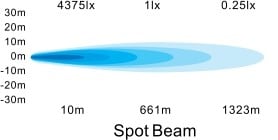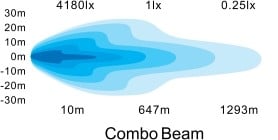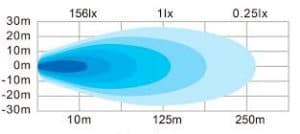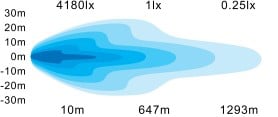Ultimate Buyers Guide: LED Spotlights Explained
Nighttime driving can be challenging, even for those with clear vision. Luckily, few options rival the brilliance and efficiency of LED spot lights for enhancing visibility when travelling on SA’s...
Free shipping on orders above R1000

Factory lights just don’t cut it for off-road adventuring, so how does one go about picking the best LED lightbarfor their 4x4? Here’s the short answer:
A combination beam LED light bar placed low on your 4x4 is your safest bet. Otherwise, you’ll either lack peripheral vision or you’ll lack power in your forward-facing spot beam. Be aware of the legislation surrounding the use of after-market LED light bars in South Africa. You’re much less likely to run into legal trouble if you make your light bar detachable and only use it when you need it.
Let’s quickly run through everything you need to know about choosing the best off-road lighting for your 4x4:
Price & Size
Step one is figuring out your budget. Not much more to say here - this is your call. You just need to be sure that what you’re buying will meet your off-road needs. Saving R1000 isn’t really saving if you’re going to redo your lighting in the near future.
Then you’ll need to measure the available space on your vehicle and decide where to place the light bar. They’re usually found on roofs, grills, bull bars, and bumpers in sizes ranging from 6 to 50+ inches.
A small LED light bar can throw a surprisingly strong punch. An 11-inch bar from the Hella ValueFit Pro Series can chuck 5400 lumens over 767 meters. You can also find 6-inch bars that shine over 322 meters.
Types of LED Light Bar Beam Patterns
Picking the right lighting for your off-road needs can be the difference between seriously damaging your metal baby and slowly but safely cruising through your obstacles. This ties back into your budget – if you get an LED light bar that isn’t good enough to keep you out of harm’s way, you’ll end up repairing damages that could have been avoided by using more appropriate lighting.
Spot Beams
Spot beams are designed for maximum range and intensity at the cost of beam width, making them great for high-speed conditions. Since spot beams only provide 10-30 degrees of vision, pairing them with flood beams can be highly beneficial. However, LED light bars do spill a decent amount of light for peripheral vision, so you could be good to go without needing to complicate your lighting setup.

Flood Beams
Flood beams sacrifice range and intensity to cover a significantly wider area. They provide up to 120 degrees of vision and are also great for work lights and reverse lights. Flood beams alone may not give you enough forward vision, so if you need to see far ahead, don’t forget to pair your flood beam with a spot beam.

Combination Beams
This is where LED light bars “shine”. Combination beams combine spot and flood beam patterns to create a more complete lighting setup. The versatility of using both optic types keeps your vehicle significantly safer while minimizing the need for wasteful upgrades. A combination beam LED light bar is more than enough for most off-road requirements – you’ll see a great distance ahead of your trail and have reliable peripheral vision.

Single Row vs Double Row LED Light Bars
Single row LED light bars feature strong spot beams at the expense of wider flood beams. If you need to see far ahead and aren’t concerned with your peripheral vision, a single row light bar would suffice.
Double row LED light bars can be programmed to function brilliantly as both spotlights and flood lights. Their wide and diverse lighting patterns make them a more one-and-done solution for both fast trails and slow crawls.
Having fewer bulbs doesn’t necessarily mean a single row light bar is weaker. The important factor is the wattage of the bulb. You could rig a single row light bar to be just as powerful as a double row bar, within reason.
Durability and weather resistance
Off-roading has more than its fair share of rocks, ditches, dust, and rain. Your LED light bar needs to be able to handle these conditions with relative ease. LED light bars from less reputable brands are known to have very little ingress protection and often fail within 6 months. A trusted product that features IP67 protection and uses stainless-steel mounting brackets should cover your off-road bases.
IP67 protection means that the light bar is resistant to dust and can be submerged under 1 meter of water for up to half an hour. If you suspect you’ll be going lower than 1 meter, IP68 offers protection for up to 1.5 meters (and the same amount of time).
LED Light Bar Legislation in South Africa
While factory-fitted LEDs are legal, after-market LED light bars are not, and should only be used off-road or on your farm.
Alta Swanepoel, a road traffic and transport expert, has stated that the reason for this is that all the lights on your vehicle need to be fitted equal distances apart from an imaginary vertical line that cuts through your car’s front logo.
LED light bars usually run right across this line, and even if you only use them off-road, it’s still illegal to have an after-market light bar on your vehicle. The best way to keep your 4x4 on the right side of the law is by using a detachable LED light bar setup.
Officers have the discretion to let you go if they’re happy with your reasoning and the appearance of your setup. If you’re clearly a farmer and your LED light bar is covered, they may decide against kicking up a fuss. However, I recommend not relying on goodwill - one day it might run out.
Where should you mount your LED light bar?
LED light bar placement boils down to the beam patterns you’re using, your lighting priorities, and where your vehicle has space.
Your safest bet is fixing your LED light bar onto your front bumper, grill, or bull bar. Low light bar placement avoids awkward glare from your bonnet or light spilling in through an open sunroof.
If you’re out in the bush, mounting your LED light bar higher will cast shorter shadows, so you’ll be able to tell the difference between a shadow and a massive hole in the ground. This obviously has huge benefits to you and your vehicle, and if you already have a roof rack that can accommodate an LED light bar, it’s worth considering placing it up high. Just remember not to place your light bar too far forward.
Spot beams can be placed nearly anywhere without causing excessive glare thanks to their incredibly narrow beam patterns. While flood beams can also be mounted up high, we recommended placing them down low for clearer vision and less glare. A combination beam LED light bar placed low on your 4x4 will meet most off-road requirements.
Remember to use the correct lights for on-road, high-traffic driving. The importance of being situationally aware of your surroundings cannot be stressed enough.
Other factors to consider before buying an LED light bar
Current and heat management
Overheating an LED can shorten its lifespan by up to 90% and creates damagingly excessive currents. A good light bar should have enough airflow within its housing to manage heat efficiently, use copper core circuit boards, and feature large aluminium heat sinks.
LED light colour temperature
Not all colours are born equal – some offer distinct advantages over others. White light is the brightest and most versatile, while amber lighting is the best for low visibility driving conditions like fog.
Colour temperature is measured in kelvin (K). Candlelight is 1900K, while daylight is around 5500K and a blue sky is 10 000K. Low kelvin lighting is great for piercing through bad weather conditions, but to see any reasonable off-road distance ahead without straining your eyes, you’ll need LED lights between 4500 and 6000K.
Warranty
No one plans to constantly cycle through light bars. Most reputable manufacturers will offer coverage for 1-10 years. Check the warranty before purchasing your LED light bar to manage your expectations accordingly.
Fabrieksligte werk gewoon nie vir veldry-avonture nie. Dus: hoe gaan mens te werk om die beste LED-ligstaaf vir jou 4 x 4 te kies? Hier volg kortweg die antwoord:
Plaas ’n kombinasie straal- LED-ligstaaf laag op jou 4 x 4, anders gaan jy óf kant-/periferievisie inboet óf jy gaan krag verloor in die straal van jou kollig wat vorentoe wys. Hou ook die wetgewing in gedagte wat die nie-standaard- of vervangingsmark van LED-ligstawe in Suid-Afrika reguleer. Die kanse dat jy met die gereg gaan bots is veel skraler as jy jou ligstaaf maklik kan losmaak en afhaal en slegs gebruik wanneer jy dit nodig kry.
Kom ons kyk vinnig na alles wat jy moet weet wanneer jy die beste veldry-beligting vir jou 4 x 4 moet aanskaf:
Prys & Grootte
Die eerste stap behels jou begroting. Dis elkeen se eie besluit. Al waaroor jy seker moet wees is dat dit wat jy koop, wel jou veldry-vereistes in ag neem: Deur byvoorbeeld R1 000 te spaar beteken net mooi niks as jy jou ligte na ’n kort tydjie moet vervang nie.
Meet dan die beskikbare spasie op jou voertuig en besluit waar om die ligstaaf te plaas. Mens vind hulle gewoonlik op dakke, roosters, bosbrekers (“bull bars”) en buffers in groottes wat wissel van 6 tot 50+ duim.
’n Klein LED-ligstaaf werp ’n verbasend sterk straal. ’n 11-Duim-staaf van die Hella ValueFit Series verskaf tot 5 400 lumen tot by 767 meter. Jy sal ook 6-duim-stawe kry wat tot 322 meter skyn.
Tipes LED-Ligstaaf-Straalpatrone
Deur te verseker jy kies die regte beligting vir jou veldry-avonture kan die verskil beteken tussen skade aan jou voertuig veroorsaak, of met geruste hart kalm en veilig deur jou hindernisse vleg. Dink weer aan jou begroting: As jy ’n swakker LED-ligstaaf aanskaf, een wat nie verseker dat jy uit die moeilikheid bly nie, sal jy noodgedwonge herstelwerk wat vermy kon gewees het met beter ligte, moet laat doen.
Kolligstrale (“Spot Beams”)
Kolligstrale is ontwerp vir maksimum trefkrag en intensiteit ten koste van straalwydte, wat hulle ideaal maak vir hoё-snelheid omstandighede. Aangesien kolligstrale slegs 10-30 grade visie verseker, kan dit baie voordelig wees as mens hulle met spreiligstrale (“flood beams”) meng. En tog: LED-ligstawe verseker ’n goeie hoeveelheid lig vir kant-/periferie of sywaartse visie; dus is dit nie nodig om jou beligting te veel te kompliseer nie.

Spreiligstrale
Spreiligstrale offer trefkrag en intensiteit op om te verseker ’n veel wyer area word gedek. Hulle kan tot 120 grade visie of sig lewer en is ook baie effektief vir werks- en tru-ligte. Spreiligstrale op hul eie gaan jou waarskynlik nie genoeg vorentoe-visie verseker nie; as jy dus ver vorentoe moet kan sien, onthou dan om jou spreiligstrale met jou kolligstraal te kombineer.

Kombinasiestawe
Dis waar LED-ligstawe tot hul reg kom. Kombinasiestawe kombineer kollig- en spreiligstraalpatrone om sodoende ’n meer volledige beligtingsituasie te verseker. Die feit dat jy ’n opsie het om beide optiese tipes te gebruik, verseker dat jou voertuig heelwat veiliger gaan wees terwyl onnodige opgraderings vermy word. ’n Kombinasie-straal LED-ligstaaf is meer as goed genoeg vir die meeste veldry-situasies – jy sal ver vorentoe kan sien en terselfdertyd goeie kant- of periferievisie hê.

Enkel Ry vs Dubbel Ry LED-Ligstawe
By enkel ry LED-ligstawe staan sterk kolligstrale uit bo wyer spreiligstrale. As dit daaroor gaan dat jy ver voorkant toe wil sien en nie juis oor jou kant- of periferievisie bekommerd is nie, dan is ’n enkel ry ligstaaf goed genoeg.
Dubbel ry LED-ligstawe kan geprogrammeer word dat hulle baie goed as sowel kolligte én spreiligte funksioneer. Hul wye en diverse ligpatrone maak hulle ’n uitstekende opsie vir sowel vinnige as stadige ritte.
Minder gloeilampies (“bulbs”) beteken nie noodwendig dat ’n enkel ry ligstaaf swakker is nie. Wat belangrik is, is die watt-verbruik van die lampie. Jy kan ’n enkel ry ligstaaf so stel dat hy net so sterk as ’n dubbel ry stawe is – natuurlik binne redelike perke.
Duursaamheid en Weerbestandheid
Veldry laat maak jou kennis met genoeg klippe, slote, stof en reёn. Jou LED-ligstaaf moet in staat wees om hierdie omstandighede met ’n redelike maat van sukses te hanteer. LED-ligstawe van minder betroubare handelsname is daarvoor bekend dat hulle baie beperkte binnedringingsbeskerming bied en dat hulle daarom dikwels binne 6 maande faal. Betroubare produkte met IP67-beskerming, wat vlekvryestaal-monteerhakies gebruik, behoort vir jou veldrydoeleindes genoegsaam te wees.
IP67-beskerming beteken dat die ligstaaf bestand is teen stof, en dit kan vir tot ’n halfuur lank onder 1 meter water gedompel word. As jy dink dat jy dalk laer as 1 meter sal gaan, is dit goed om te weet dat IP68-beskerming bied vir tot soveel as 1.5 meter (met dieselfde tydsduur).
LED-Ligstawe: Wetgewing in Suid-Afrika
Terwyl fabriekgemonteerde LED’s wettig is, is ligstawe wat jy na die tyd aanbring (vervangingstawe), nie wettig nie – jy behoort hulle slegs vir veldry, en op jou plaas, te gebruik.
Alta Swanepoel, ’n padverkeer- en vervoerekspert, sê dat die rede hiervoor is dat al die ligte op jou voertuig só gemonteer moet word dat dieselfde afstande tussen al die ligte geld as ’n verbeelde vertikale lyn getrek sou word deur jou voertuig se voorste logo.
LED-ligstawe sny gewoonlik dwarsoor hierdie lyn, en selfs al gebruik jy hulle slegs vir veldrydoeleindes, bly dit onwettig om ’n vervangingstaaf op jou voertuig aan te bring. Daarom is die beste raad wat jy kan volg om jou 4 x 4 aan die veilige kant van die wet te hou, om ’n LED-ligstaaf wat jy kan losmaak en afhaal, te gebruik.
Verkeersbeamptes (en polisiemanne) kan hul diskresie gebruik en jou laat gaan as hulle tevrede is met jou verduideliking en hoe jou montering voorkom. As dit duidelik is dat jy ’n boer is en jou LED-ligstaaf bedek is, mag hulle jou dalk net sonder problem laat gaan. Maar, dit bly ’n kans wat jy vat - en eendag mag die geluk net teen jou draai!
Waar Moet Jy Jou LED-Ligstaaf Monteer?
Dit hang grootliks af van die straalpatrone wat jy gebruik, jou prioriteite met betrekking tot jou beligting, en waar op jou voertuig daar spasie is.
Jou veiligste opsie is om jou LED-ligstaaf op jou voorste rooster, buffer of bosbreker (“bull bar”) aan te bring. Deur die ligstaaf laag aan te bring verhoed jy ongemaklike glans/ligskynsels van die enjinkap af, of dat lig deur ’n oop sondak inkom.
As jy in die bos is en jou LED-ligstaaf hoёr aanbring, sal jy vind dat skaduwees korter is; daarom sal jy die verskil tussen ’n skaduwee en ’n groot gat in die grond opmerk. Dit hou vir jou en jou voertuig groot voordeel in, en as jy reeds ’n dakrak (“roof rack”) het met plek vir ’n LED-ligstaaf, is dit dalk net ’n goeie idee om dit hoog op te monteer. Onthou net om jou ligstaaf nie te ver vorentoe te plaas nie.
Kolligstrale werk van omtrent oral af sonder om buitengewoon erge glans/ligskynsels te veroorsaak danksy hul baie dun straalpatrone. Terwyl spreiligstrale ook hoog op gemonteer kan word, word dit aanbeveel om hulle laer af te plaas vir helderder visie en minder glans. ’n Kombinasiestraal- LED-ligstaaf laag op jou 4 x 4 gemonteer sal vir die meeste veldrydoeleindes geskik wees.
Onthou om altyd die korrekte ligte te gebruik tydens normale én besige verkeer. Dit kan nie genoeg beklemtoon word hoe belangrik dit is om van alles rondom jou bewus te wees nie.
Ander Faktore Om Te Onthou Voor Jy Jou LED-Ligstaaf Aanskaf:
Stroom en Hitte
Oorverhitting van ’n LED kan sy lewensduur met tot 90% verkort en buitengewone stroom veroorsaak wat tot groot skade kan lei. ’n Goeie ligstaaf behoort genoeg lugvloei in sy omhulsel (“housing”) te hê om hitte behoorlik te versprei, dit behoort koper- kernstroombaanbord (“copper core circuit board”) te gebruik en voorsien te wees van behoorlike aluminium hittebak (“heat sink”).
LED-Lig Kleurtemperatuur
Nie alle kleure is dieselfde nie – sommiges het besliste voordele bo ander. Wit lig is die helderste en mees veelsydige, terwyl amberagtige kleure beter is vir lae/swak/beperkte sig omstandighede, soos om in mistige weer te moet bestuur.
Kleurtemperatuur word in kelvin (K) gemeet. Kerslig is 1 900K, daglig rondom 5 500K en ’n blou hemel 10 000K. Lae kelvin lig is goed vir bestuur in slegte weer, maar om seker te wees jy sien enige redelike veldry-afstande voor jou sonder om jou oё uitermate te moet inspan, gaan jy LED-ligte tussen 4 500 en 6 000K moet gebruik.
Waarborg
Niemand wil aanmekaar ligstawe vervang nie. Die meeste betroubare vervaardigers verskaf 10-jaar dekking. Kyk eers na die waarborg voor jy jou LED-ligstaaf koop sodat jy weet wat om te verwag.